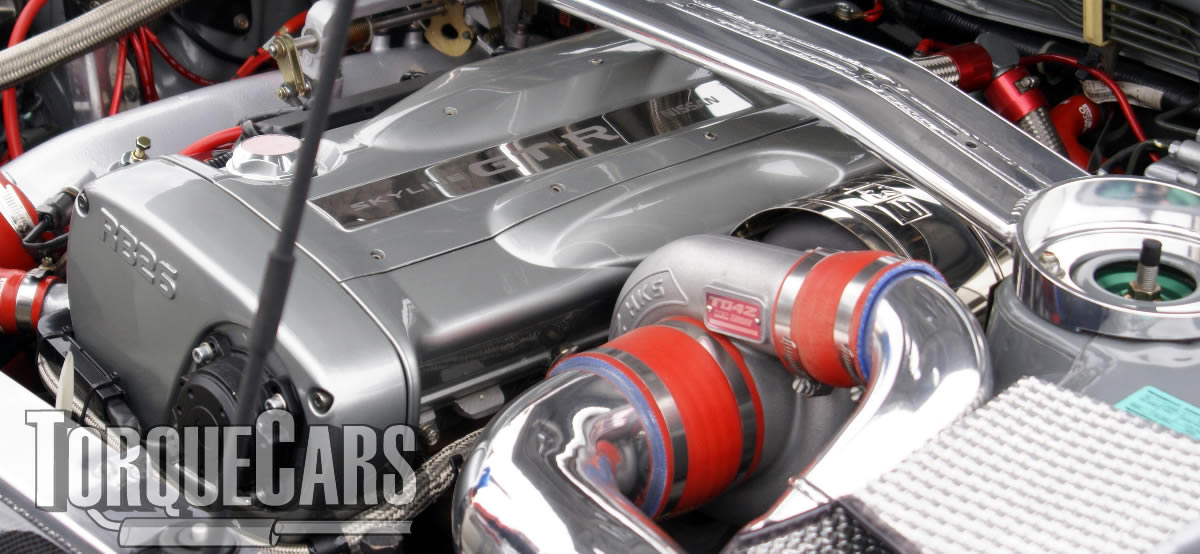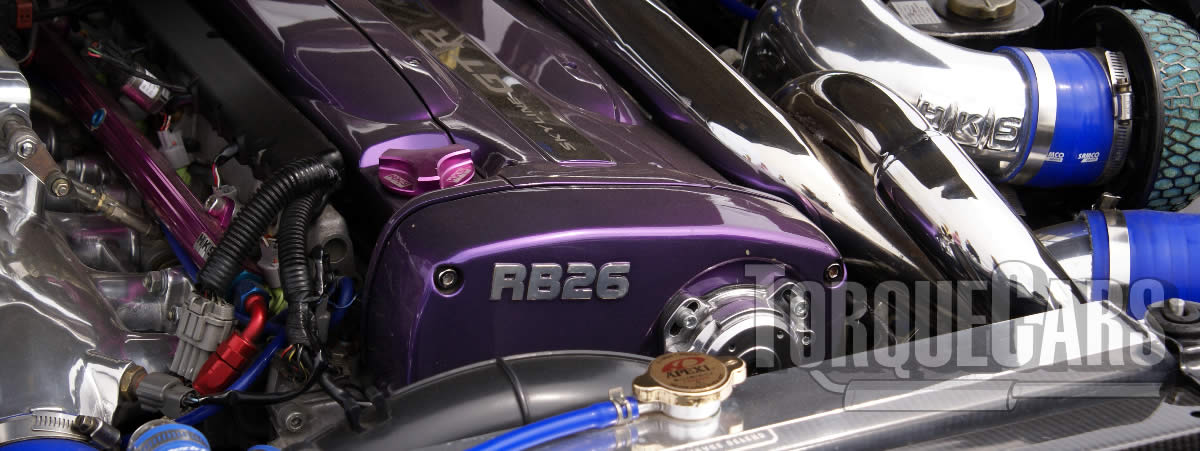Modifying and improving: "RB26DETT Engine Tuning"
RB26 performance tuning Guide
"RB26DETT and N1 Tuning"
The production of RB26 engines took place from 1989 to 2002 and was shaped as a precise fit for the GTR R32. It gained a solid reputation among today’s tuners because of the high quality components used, it's free revving attributes, and overall solidity.
Due to the many inquiries and questions that we get for tuning the RB26, we decided to collate some of the replies, recommendations, and suggestions we got from our readers on the TorqueCars RB26 tuning guide into this article. Often, the RB26DETT is chosen for other cars such as the Silvia, 300zx, and 350Z.

We are glad to see that the RB26DETT has lots of upgrades and performance parts around today. The main objective in RB26 tuning is primarily to get the power on early in the rpm band. The
Gold top, N1 edition of the RB26DETT
N1 edition, the Gold Top which is arguably the best base to work on for your tuning project, was built to be stronger and tuned to create more power.
The Gold Top used a Garrett M24 Turbo and had cylinder block improvements to enhance the oil delivery and better cooling.
If you are on a budget, the N1 will make a top choice, it has a much better oil and water pump, and that makes it a good upgrade to the standard RB26 engines.
However, your best bet will be to buy upgrades from aftermarket part suppliers namely, Tomei, Jun and Greddy for water and oil pumps.
The pistons and rods on the N1 were strong and durable, and this also makes a better base for you to work from. The RB26DETT has a wide variety of options to pick from, what you need to decide on is your power target first, then you can plan from there.
The standard engine is built to perfection, and its built makes it unique for a production car engine that anyone can find around which is built to handle 600bhp thanks to the supporting engine components to deliver the right amount of fuel and air to reach this level of power.
Many times we are asked which one to choose between MAP or AFM, well, we tend towards the MAP sensor because it gives better results, while the AFM’s can be tough to setup and struggle at higher power figures.
The standard turbo is not compatible with tuning that is over 340bhp. The N1 edition also offers an upgraded turbo which provides more air that will help you push power levels up to 400.
If you want a power boost on your daily driver, the turbos from HKS , namely the 2510 or 2530, and the Garrett T3 are good options, especially because they offer the low lag and good wide spool range.
You would also find a triple plate clutch a smart investment because it will ensure that clutch slipping does not lose your power gains.
We always advise that people should not try to cut corners because that will cost a fortune in repairs and repeated modifications to get a higher standard.
For any tuning projects, engine management must be taken seriously, for this purpose, our in-house RB26 fans always recommend a Link G4+ (or any G4 that comes with external knock control unit) or Syvecs ECU (you will find the updated data logging feature extremely useful). For starters, set aside about a full year’s salary to fund your RB26 tuning project beyond 400bhp level.
Which is better - a Big turbo or twin turbo?
This is a debate that may never be settled. Well, we joined in the debate by trying both kinds of engines. We installed a modern GTX large turbo billet turbo which was built to produce a similar boost to the stock setup.
The big turbo outperforms the stock twin turbo setup throughout the time set aside for the whole rev range. Stay watchful and careful when running stock internals, because the big turbo creates much more power and will highlight any weak spots.
The newer and better twin scroll turbos from Borg Warner (EFR's) are easy to love, they are exciting, and they deliver power right across the entire rev range.
Don’t forget that we are comparing a cutting-edge modern big turbo which comes with latest features and flow optimizations, with a 20-year-old twin turbo technology.
That’s why it’s generally accepted that the big turbo has the upper hand, but if you compare a modern big turbo with a modern twin turbo, you'll have more uncertainties – the performance gap will be closer all around with pros and cons for each.

We suggest that if you keep your stock internals you should use a twin turbo setup.
Regardless, if you are prepared to upgrade internal components, a big turbo still wins without a doubt if you are looking for bigger power and looking for large power gains. In our opinion, a big single turbo conversion is great as an upgrade on all RB26's engines.
The designs are more modern, and you get a massive top end potential and good low down power. For high revving stock engine internals, low boost (around 9psi) is your best bet.

For better safety when using the top end from bigger turbos, you can update the internals.
The twin-turbo design is pretty good; it has a logical upgrade path that will allow you to hit much higher power levels without getting the lag you get with many older large turbo setups. For this year (2017), the top choice turbo for RB26 engines is a Borg Warner EFR.
The rate at which the RB26 engine fires makes a twin scroll turbo take in a solid bet for upgrades. The twin turbo exhaust gases draw power from the other cylinders; one uses 1,2 and 3 and the draws power from 4,5 and 6.
This smooths out the unbalance exhaust pulses, and this is what you look for when you switch to a big single turbo – you want the turbo to spin smoothly.
A twin-scroll turbo draws the exhaust flow seamlessly into the turbo intake, and the turbo turbine profile is optimised to match each scroll.
That’s why it appears like the twin scroll headers are complicated, but all of these combine to help in balancing the exhaust flow and gives a smooth power delivery and fast spool up.
The multifarious lengths into the turbo are delicately shaped and designed to create a steady flow of exhaust at the right time.
Aiming for 400bhp-650 bhp
When you decide to go over 400 bhp, you have to prepare for some big-time turbo upgrades. Back in the days, the GT2530 was a popular option for large power gains, but we prefer the newer and better twin scroll Borg Warner EFR 8174 or the more substantial EFR 8374 (great for 500-800bhp).
Essentially, you'll need to upgrade your clutch, suspension, and brakes when tuning a car.
We realize that many people focus on power gains for their tuning projects and neglect power delivery and handling. Hence, we recommend a 1.2mm metal head gasket for larger power gains around 650 bhp, and when running power boost up to 1.4 or more, we prefer NGK heat range 8 Sparkplugs.
To get a better result, you can also fit a progressive boost controller and race spec main bearings. Although, you may find an aftermarket ECU harder to set up but, the benefits cover for it; you will certainly get better performance.
It helps to optimize the timing and fueling to a moderate degree of accuracy - we always choose a Link G4+ (or any G4 with external knock control unit). Better still, if you are not bothered about cost, you can go for the more expensive Syvecs ECU (the uprated data logging feature is very useful).
Boost it with a high-performance fuel rail, 1000cc injectors, and the GT2860-5, EFR8374 or GT2871R turbo with a strong fuel pump (your best bet is for you to specify for around 280 liters per hour).
If you want to build a track day car, cams will be helpful; it will make a significant improvement in the power band. Working on a road car, don't be too invested with the cam profile.
Tuning to the 600-900 bhp mark will take some serious investment.
If you want to give the engine more power, you could specify a T88-34D turbo, HKS T04Z, or preferably the Borg Warner twin scroll EFR 9180.
Fit a strong stroker kit that will take the RB26 to 2.8 liters and matched to a ported and suitable flowed cylinder head, and forged internals will safely raise power levels to around 800bhp. RB30 is hugely compatible with a large power project car.
Give it a race spec wastegate, (3 layer radiator and intercooler), race spec head studs and big valve head conversion to help stretch power up to the 870bhp levels.
Some of our forum members and RB26 owners have pushed up to 800bhp on standard internals.
We always recommend equal parts and forged parts for the higher power levels. Frankly, the rpm range engine is good for revving unlike many other high power engines, so it will be terrible to limit it because of unbalanced or weak internals.
RB26 DETT common problems and weaknesses
The weak spots; heavy loads usually cause oil starvation, and this always results in the oil pump failing.
It gets worse when you always need more oil; it can cause substantial damage to the engine.
The newer model N1 is compatible with an uprated oil pump which prevents oil starvation, but you can get better aftermarket oil pumps from Tomei, Jun, and Greddy.
Ignition coils can also fail, it often occurs as a flat spot or misfire. If they ever fail, do not hesitate to replace them with higher spec parts. If you are keen on maintaining the engines in good condition, they will require regular servicing and ensure to make use of correct grade fully synthetic oil.
Please use the comments box below to add your suggestions and experiences using the engines; we don’t think it is possible to attend to all the concerns in our article.
Therefore, we are always glad when our readers to add their tips, suggestions, and comments to help keep us at a vantage point so that we can also stay abreast of trends.
We are currently working on an RB25 tuning guide of our own, but the link is to a great guide on TorqueCars that gives and in depth look at RB25 tuning options.
If you liked this page please share it with your friends, drop a link to it in your favourite forum or use the bookmarking options to save it to your social media profile.
Check out TorqueCars new YouTube channel, and see their awesome new content...
Feedback
Please use our forums if you wish to ask a tuning question, and please note we do not sell parts or services, we are just an online magazine.
Help us improve, leave a suggestion or tip
